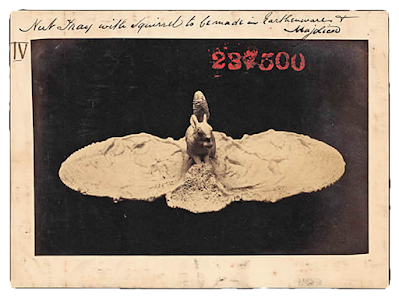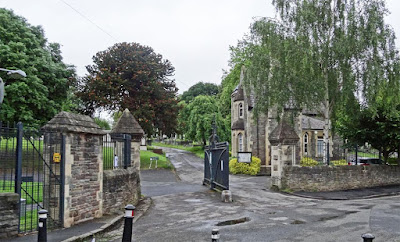George Jones majolica is one of the most coveted names in majolica. It's very easy to see why this is the case. Majolica made at the George Jones factory is some of the most elegantly designed, whimsical and beautifully crafted majolica ever created.
The great demand for Jones majolica, and the great prices that the demand brings, have elevated the Jones name to the pantheon of fame and collectibility usually reserved only for great eighteenth century pottery names like Meissen or Josiah Wedgwood. And just like Meissen and Wedgwood, the Jones name is one of the most abused names in pottery. Some of this abuse is intentional, created by people hoping to make a dishonest buck but some of this abuse is simply ignorance based in the irregular manner in which Jones marked its majolica. Of the top three potteries in majolica—Minton, Jones and Wedgwood—Jones was the least consistent in the marking of their wares. The confusion this causes is hard for general pottery dealers and beginner collectors to understand, but it is this confusion we will try to clarify in this post. First a little background.
History
George Jones was born in Nantwich, Cheshire on June 27, 1823. He began as a potter's apprentice in the Minton factory in 1837 and remained there until 1844. From 1844 to 1845 he worked as an agent of Wedgwood & Boyle of Etruria. Dismissed by Wedgwood & Boyle in 1845 he became an itinerant clerk and salesman, the same year he married milliner Frances Jackson, a union that was to eventually produce eight sons and three daughters. In 1850 Jones opened his own business as a commission agent and earthenware broker, establishing relationships with many of the businesses in the Stoke-on-Trent area.
In 1856 Jones opened his first pottery showroom and five years later opened his own pottery at Bridge Pottery, one which produced utilitarian cream ware, toilet items and some decorative ware. Participating in the 1862 London Exhibition brought Jones some fame for the quality of his wares and he continued to expand into more decorative and tableware items. In 1864 Jones expanded into a larger facility first called the Trent pottery and later the Crescent Pottery. It was around this time that Jones set up his own majolica works. Unfortunately in 1865 a devastating fire damaged the pottery forcing a curtailing of operations. Jones rebuilt the facility but suffered a second fire the following year. Again, Jones rebuilt and used the opportunity to expand the works.
Beginning in 1866 Jones began potting majolica in direct competition with the two largest majolica manufacturers in Staffordshire, the Minton and Wedgwood factories. In the 1870s Jones' majolica developed a reputation for its quality and soon became a large portion of the company's business.
Jones seemed to know that the key to great majolica was in the basic design of the ware. For this he depended on his designer John Bourne, and on his son, Frank Jones who was trained in pottery design in France. Perhaps this French connection explains the strong Art Nouveau influence on many GJ designs.
George Jones' Trent Pottery at Stoke-On-Trent c. 1865
The great beauty of Jones work has rarely found an equal in nineteenth century English pottery being surpassed perhaps only by Minton. Add to that an appreciation for the impeccable craftsmanship that distinguished Minton and Jones majolica and you get a pottery that is spectacular in its beauty and glorious in its execution. The work was described by Llewellynn Jewitt in
The Ceramic Art of Great Britain (1878
):
The firm also make a large and striking variety of articles in majolica, in which they successfully view with most houses in the trade. In this they make both useful and ornamental articles, most of which are of a high order of art, being well modelled (sic), carefully finished, and of a quality that will bear comparison with most others. Some of the productions exhibited at Paris in 1867 (when they obtained a medal), at London in 1871, and at Vienna in 1873…
The imitation Palissy ware is highly successful. In vases, candelabra, centre and side pieces, flower shells, and numberless other articles, Messrs. Jones have produced many striking and good designs…especially an aquatic centre-piece… in Cupids, shells, dolphins, and coral; a flower-pot, in which the magnolia forms the basis of ornamentation; and an ew^er(sic) abundantly decorated with lizards, snakes, &c.(sic),are bold, good, and highly effective in design.
By 1880 the company was exporting 50% of their product to the United States. In the early 1880's a recession hit the industry hard and majolica sales declined. Most majolica manufacture at the GJ pottery ceased by the late 1880s, approximately twenty years after the first introduction of majolica at the plant. The majolica molds continued in use but were repurposed to create other wares in different bodies.
Engraving from The Ceramic Art of Great Britain
George Jones majolica acanthus garden seat
George Jones majolica apple blossom cheese keeper
George Jones majolica bee skep cheese keeper
George Jones majolica hunt tankard
George Jones majolica finch butter dish
George Jones majolica primrose jardiniere
George Jones majolica marmalade
Marks
Jones marked his majolica wares in a number of several variations of the impressed monogram "GJ". From 1866-1877 he used the simple monogram letters GJ either plain or enclosed in a circle .
A second mark used during this early period is an applied pad in a double gourde shape that is attached to the underside of the greenware before firing. This pad has the "GJ' monogram but also the words "Stoke on Trent" in a semicircle underneath it. Written above this GJ is the piece's shape number code from the company pattern books. This mark was in use until 1878.
A third mark found on Jones majolica is a simple oval shaped mark that kept the "Stoke on Trent" but also added "Stone China" to the impression. This too was used until 1877.
Although he had brought his two elder sons Frank Ralph Jones and George Henry Jones into the pottery business as early as 1866 it was not until 1878 that he also added them to the company name. Two more sons, Charles And Horace eventually also joined the operation, now legally forming a partnership between Jones and his four sons. From this point on the words "and Sons" appeared on the majolica usually enclosed in a crescent moon shape. This quickly resulted in the nickname "crescent" pottery for the George Jones company, a name the company eventually adopted as a trademark.
If these GJ marks were universally impressed into Jones majolica the way Minton's marks were universally applied to their pottery, it would be easy for just about anyone to identify Jones majolica. Unfortunately, Jones was not terribly interested in taking credit for all their products so these marks are usually missing from the underside of the pottery. In fact, it's probably safe to say that less than a half of the company's majolica output is actually marked. This is where the confusion begins in identifying Jones majolica. This is why we need to rely on other characteristics and marks to identify Jones' wares.
One thing that remained consistent about the company was the application of their pattern numbers on the underside of their majolica shapes. As mentioned earlier, these numbers were taken from the company pattern books and were applied by hand on an unglazed area, or "thumbprint" as some call it, on the base of the piece.
The presence of such a mark is often the only way one can identify these wares as virtually all Jones pieces bear such a mark. If one looks up the above number in the surviving pattern books (available in the index of Victoria Bergesen's book
Majolica: British, Continental and American wares 1851-1915),
3450 is the number for the Monkey handled tea ware.
George Jones majolica monkey handled tea service
Sure enough this number is on the underside of the matching tea tray.
Another mark seen in the above image is the
English Registration mark. If we read the mark it tells us that this design was registered by Jones on June 26, 1875. That's not the date the piece was made, only the day it was registered. English Registration marks are common on Jones majolica but since they were also used by other potteries in Great Britain, its presence alone is not enough to identify a piece as having been manufactured at the Jones plant. Jones began registering patterns specifically intended for majolica in 1869. The last design for majolica was registered in 1882.
Below are a few pages from the registration books with Jones designs.
Other marks one may find on the underside are both capital letters and numbers which were part of Jones' pottery dating system, which was in place from 1862 to 1914. In this system the month was represented by numbers 1-12. The letter system is rather complicated involving large letters and small letters. Even then it isn’t entirely dependable and still relies on some knowledge of the company’s product to date a piece correctly. It was compiled by Robert Cluett in his wonderful book
George Jones Ceramics 1862-1951.
Other Identification
A defining characteristic of Jones majolica is the distinctive snakeskin mottled glaze on the underside, very different from the tortoiseshell mottling used on the underside of Wedgwood, the muddled mottling of Forester or speckled mottling on the base of Holdcroft majolica. An example of it can be seen below on the “Pink flowers” dessert plate.
Underside of Jones plate showing the distinctive snakeskin pattern.
The impressed 9A in the center indicates a production date of either September 1901 or
September 1875. The absence of the word ENGLAND allows us to reliably date it to 1875.
This mottling isn't always present though or as clearly defined. Some hollowware pieces are glazed on the underside in ivory, pink, turquoise or the color of the obverse, but it is present most of the time and always present on flat ware like plates and platters.
Even though Jones didn't mark much of its majolica, identifying those pieces that don't bear the JG monogram isn't difficult if you know what else to look for. With a little practice, anyone can learn to recognize them at first sight.
George Jones catalog page showing serving pieces
George Jones died on August 18, 1893 at the age of 70. He is buried in Greenbank Cemetery in Bristol. The Trent Pottery continued operations into the 20th century as the Crescent Pottery first under the management partnership of the four sons and later different owners until it closed in 1951.
George Jones majolica is liberally reproduced today. For more on common reproductions go
here.
Unidentified man from the Jones family album believed to be George Jones
Greenbank Cemetery, Eastville, Bristol Unitary Authority, Bristol, England






















































































